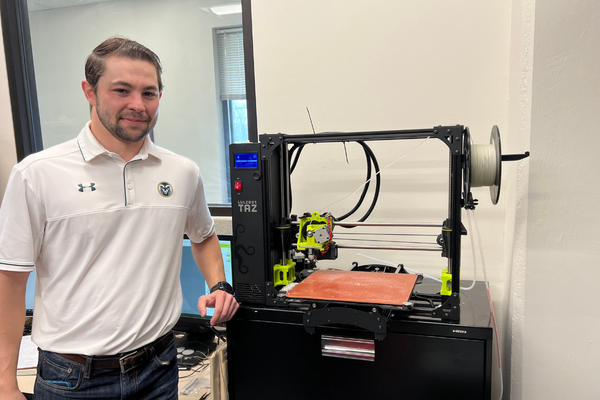
Evan DeVincenzo
Graduate Student, Radiological Health Physics
I grew up in Arvada, Colorado, near the Rocky Flats Plant which made nuclear components starting in 1952. When I was in elementary school, the EPA began the long process to mitigate the radioactive contamination of the ground and surrounding areas.
Seeing that whole process unfold sparked an interest in radiation in me that ultimately guided my career. After high school, I attended Colorado State University and earned a degree in physics and mathematics. My favorite classes included radiation safety and dosimetry.
After college, I worked for a few years as an electrical engineer. It didn’t take long for me to realize that I wanted to go back to school to pursue a degree more closely aligned with my interest in radiation and its promise in the world of healthcare.
I applied to the Radiological Health Physics graduate program at Colorado State University and started in the Fall of 2021. My graduate project is building off existing literature and studies to see if we can more accurately capture data about how much radiation dose is administered and eventually find ways to irradiate infected areas more accurately while preserving healthy tissues.
Sometimes, when radiation is administered, a material called bolus is used as a buffer between the patient’s skin and the radiation accelerator. These bolus materials help protect healthy tissue from radiation and increase the amount of radiation the tumor absorbs.
While many improvements have been made in terms of exacting treatment, there are still unknowns when it comes to radiation therapy – namely in determining just how much radiation each patient absorbs in difficult to measure areas. With current technology, we can model the amount and calculate but there are limitations within the software and no direct measurements. With my project, I am creating a system in which accurate measurements are easy to ascertain.
As part of my project, I’m 3D printing new boluses that have optically stimulated luminescence particles in the material. After the patient is radiated with the bolus in place, the luminescence material gets excited and later emits light. The amount of light it emits correlates to exactly how much radiation was absorbed.
Determining exact dose rates is important because it will allow us to minimize the dose to healthy tissue. This will create more effective treatments, with fewer overall side effects. It can also help reduce some of the inefficiencies in radiation therapy and streamline treatment.
I am currently experimenting with the bolus materials. I will defend my project in the summer of 2023. After I graduate, I plan to continue to work in radiation oncology research, more specifically 3D printing of bolus materials – this field is exploding and it’s amazing to be at the forefront of improving treatment and outcomes.
When I’m not working or in class, I’m a triathlete and compete for Team USA. I have qualified for five world championships and am currently training for ITU Worlds in Spain in September 2023. I have a labradoodle named Chewie and I love to be outside.
Working in the Radiation Biology and Therapy program at the Flint Animal Cancer Center has been transformative for my career. I have learned so much about the importance of treating cancer in humans and pets with radiation therapy – information I will take with me throughout my whole career.